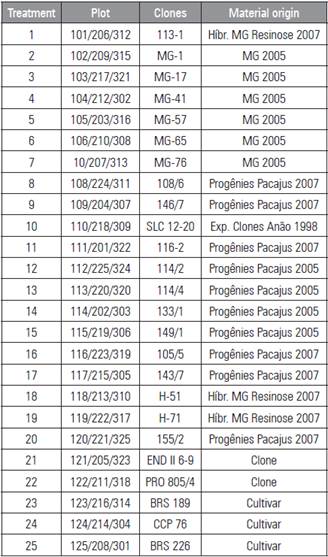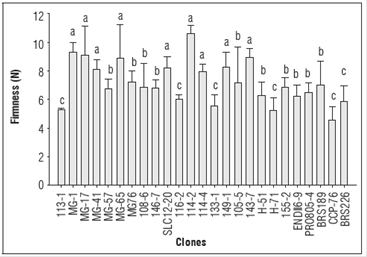INTRODUCTION
Physical variables such as appearance, size, color, shape, firmness are of great importance since they are the main characteristics that attract consumers. However, one should seek to meet the requirements of the intended market according to their needs, depending on the type of product to be obtained from the selected clone (Almeida et al., 2018). Qualitative attributes such as color, size, firmness and shape are more important than quantitative ones in physical analyses because they assist in the establishment of the fruit harvest point (Lopes, 2011).
Moreover, these are of great importance in marketing since they are the main characteristics available to consumers, who prioritize buying fruits that visibly have a more attractive appearance. Fruit quality is genetically established, so there is no human intervention because quality is determined by the capacity of genes. However, for expression to occur at the full genetic potential, plants are subject to several factors, such as nutritional requirements and appropriate soil and climatic conditions (Aular and Natale, 2013).
Nutrients and minerals interfere significantly with fruit quality and productivity, where soil fertility is one of the main factors for the development of the genetic potential of plants. Considering that a chemical analysis of the soil is necessary in order to characterize its capacity to provide nutrients, so that, each type of soil can be suitable for the cultivar to be produced (Wang et al., 2015).
In order to meet the main interest in the final product, the desirable characteristics for a clone to present good peduncle production are: low plant size to facilitate manual harvesting and to avoid damage the product; peduncle with color ranging from orange to red, pyriform shape, masses ranging from 100 to 140 g and have good firmness (Moura et al., 2015). Therefore, the objective of this study was to evaluate peduncles of different clones of dwarf-cashew in order to infer the physical characteristics for later indication for natural consumption and/or processing.
MATERIAL AND METHODS
The cashews (peduncle and chestnut) from dwarf cashew clones came from an experimental unit that is being evaluated in an experiment on competition of dwarf cashew clones in Cruz - CE, in the microregion of the Coast of Camocim and Acarau mesoregion, do Noroeste Cearense, with the geographical coordinates: Latitude: 02°55'04" S and Longitude: 40°10'18" W, average rainfall: 1,136 mm and average temperature: 23.0°C.
This experiment was conducted under field conditions from September 2017 to September 2018. The experiment design was a randomized block, with 25 treatments (Tab. 1) with 4 plants and three replications. The treatments consisted of different dwarf cashew clones that were previously selected based on the local edaphic and climatic conditions, with CCP 76 as a control. CCP 76 was chosen as a control because its features are considered the industry standard: good palatability, good proportion of soluble solids, titratable acidity, and color that appeals to consumers, etc. Peduncles were harvested at the end of September 2017 in the early hours of the morning and immediately packed in plastic boxes with only one layer of fruits, protecting them from mechanical injuries.
According to the variables: total cashew mass (MT), chestnut mass (MC), peduncle mass (MP), apical diameter (AD), basal diameter (DB), length and firmness, the cashews were characterized, with MT (g) (cashew nuts and peduncle) - measured by weighing each individual fruit on a semianalitic balance; MC (g) - determined after cashew weaning by weighing the cashew nut on a semianalitic balance; MP (g) -obtained with the difference between the total mass and the cashew nut mass; length, BD (near cashew nut) and AD (side opposite side of the cashew nut) of the penducle (mm), measured with a digital caliper; and peduncle firmness (N), determined using a Mc Cormick model FT 011 with 8 mm diameter nozzle on two points on opposite sides of the medial part of the peduncle.
The experiment design was a randomized complete block design (DBC) with 25 treatments (clones) with 3 replications and up to 12 cashews per plot (four plants in total). The results were submitted to the normality and heterogeneity of variance test, and then the F test was performed, which showed significant difference between the evaluated clones. The analysis of variance (ANOVA) was performed using the Genes software, and for the comparison of the means, the Scott and Knott test at 5% probability was used. Differences were considered significant when P<0.05 (Banzatto and Kronka, 2013).
RESULTS AND DISCUSSION
The statistical analysis revealed a significant effect from the treatments (clones) on all evaluated characteristics. Because of the large number of clones, it was convenient to separate them into groups to facilitate an understanding of the results. The criterion of separation in groups was the significant difference between them, which followed a decreasing order of the means, that is, group 1 will always present clones with higher averages for the variables. Each group consisted of clones that did not differ from each other. Depending on the analyzed variable, the number of groups changed according to the need to group clones with the same importance. The clones have always been compared to the control since it has the characteristics desired for natural consumption and processing markets.
The total mass (MT) of cashew varied from 66.45 to 143.36 g, with a 76.91 g amplitude and a general average of 105.53 g (Fig. 1). However, the classification of the cashews was based on the number of fruits per tray, which usually ranged from 4 to 9, corresponding to an average total mass of 600 g (Moura et al., 2015).
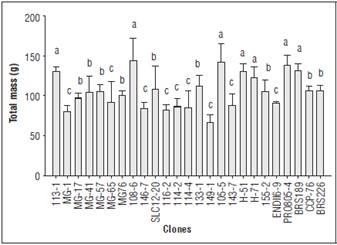
Figure 1 Total mass of cashews of dwarf cashew clones from Cruz, CE. 2017. Averages followed by the same letter do not differ from each other according to the Scott and Knott test (P≤0.05) (n=3) ± standard error. Values between 113.27 and 150.82 g are considered ideal.
In the present study, the clones 108-6, 105-5, PRO805-4, BRS189, 113-1, H-51 and H-71, of this group had values between 102 and 143.36 g and were classified as type 4 cashews / tray. Group 2 (the control CCP-76 (106.57 g), 133-1, SLC12-20, BRS226, MG-57, 155-2, MG41, MG17 and MG76) had TM values that were 97,07 to 112.07 g and clones classified as type 5 cashews / tray. Group 3 (MG-65, ENDII6-9, 143-7, 114-2, 114-4, 146-7, 116-2, MG-1 and 149-1) had TM values between 66.45 and 91.49 g and clones classified as type 6.
In general, the present study showed that the objectives of genetic improvement of dwarf cashew clones are being reached since the values of type 4, 5 and 6 (4, 5 and 6 cashews per tray.) are considered the market standard because they were obtained by evaluating the variable TM.
Thus, Moura et al. (2001), working on the physical characterization of peduncles of cashew clones for natural commercialization, obtained average masses for the cashews in a study with nine clones that ranged from 88.5 g to 155.4 g; the maximum value of BRS 189 clone was lower to that found in this study.
For the CCP76 control in the aforementioned studies, they found values of 150.8 and 155 g (respectively) for TM; this clone is the mass standard for natural commercialization. However, they were superior to those found in this study for this same clone, possibly because first experiment was irrigated and the second work was carried out in 2006, which presented annual rainfall (1,151.2 mm), the annual average of the year of accomplishment of this work, 2017 (190.2 mm) (Moura et al., 2001).
Lopes et al. (2011), working with the physical characterization of peduncles of dwarf cashew clones at different maturation stages, obtained average masses for cashews that varied from 80.28 g (BRS 189) to 83.72 g (CCP 09). The value of the BRS 189 clone was lower than that found in this study. On the other hand, when evaluating the clones CCP 76 and BRS 265, which had the highest and the lowest mean of total mass, 113.27 and 54.36 g, respectively, CCP76 presented an average value higher than that found in this study, probably because of the local climatic conditions of the studied areas.
The present study showed that a variation of 55.01 to 130.64 g, with an amplitude of 75.63 g and an overall mean of 95.16 g (Fig. 2), was observed for the peduncle mass (PM). Group 1 (108-6, 105-5, PRO805-4, BRS189, 113-1, H-51 and H-71) was composed of clones with a higher PM, and the values of this group were between 112.43 and 130.64 g. It is important to highlight that they obtained higher values than the control. Group 2 (the CCP-76 control (98.39 g)) next to clones 133-1, BRS226, MG-57, MG-41, MG-17, SLC12-20, 155-2 and MG76). They presented variations for averages between 87.77 and 101.33 g, inferior to group 1 and superior to the other groups. Group 3 (114-2, MG-65, ENDII6-9, 143-7, 146-7, 1144, 116-2, MG-1 and 149-1) had PM averages between 55.01 and 82.16 g. The CCP 76 clone was studied by other authors. Comparing the two studies, it is possible to see that, in the first case, the clone obtained values of 92.7 g, lower than the one found in this study (Pereira et al., 2005).
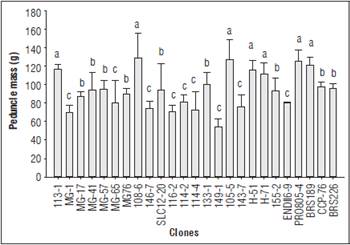
Figure 2 Peduncle mass of cashews of dwarf cashew clones from Cruz, CE. 2017. Averages followed by the same letter do not differ from each other according to the Scott and Knott test (P≤0.05) (n=3)±standard error. Values between 101.03 and 141.80 g are considered ideal.
On the other hand, it was higher than the one obtained in this study, with an average of 172.5 g (Lopes et al., 2011), which can be explained by the high rainfall of 1,925.2 mm during the course of the experiment, about 10 times more than the rainy season during the present study. It is worth mentioning that the area of the experiment was also different, so possibly other factors may also have been involved in these differences.
Abreu (2007), when analyzing clones CCP 76 and BRS 226, obtained PM values of 145.80 and 144.52 g, respectively, values higher than those found in this study because of the difference in the amount of water received by the plants in the rainy season since it was also done under dry conditions. In order to provide greater gains in the processing of the peduncle, cashews with higher MP values are much more attractive since processing industries look for a greater yield of pulp.
The differentiation of the peduncles between clones is important so that there is separation and standardization during the process of directing for export and supplying the various markets. Standardization makes the economic exploitation of this product more attractive because of the ease in choosing the type of peduncle that meets consumer need.
According to the present study, there was a variation of 8.18 to 15.08 g in the mass of the cashew nuts (CM) of the different dwarf cashew clones, with an amplitude of 6.9 g and a general average of 10.79 g (Fig. 3). Group 1 (114-2 and 105-5) was composed of the clones that reached the highest CM values, which were 13.84 to 15.08 g, higher than the control. Group 2 was composed of clones (SLC12-20, 108-6, H-51, 113-1, and 114-4), which presented values between 11.94 and 12.77 g and also stood out when compared to the value of the control. Group 3 (149-1, 1552, PRO805-4, 143-7 and H-71) had clones with CM values that were between 11.04 and 11.43 g, standing out from the control. The control CCP 76 was used as the control group (133-1, 116-2, MG-65, BRS226, MG-1, ENDII6-9, MG-57, MG17, BRS189, MG76, MG 41 and 146-7), which presented MC values between 8.18 and 10.73 g; the control had the lowest. Among the groups mentioned, 1, 2 and 3 can be highlighted because of large-sized almonds, which are appreciated by the chestnut processing industries because of the excellent mass, which may provide type SLW almonds (Special Large Whole) and corresponds to 180 almonds/453.59 g (the minimum yield of almond for commercial production is 20% of the mass of the chestnut).
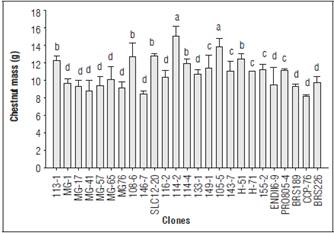
Figure 3 Chestnut mass of cashews of dwarf cashew clones from Cruz, CE. 2017. Averages followed by the same letter do not differ from each other according to the Scott and Knott test (P≤0.05) (n=3)±standard error. Values between 9.02 and 11.47 g are considered ideal.
In a study evaluating the physical attributes of peduncles from different clones at different stages of maturation, it was observed that CCP 76, at stage 7 (commercial maturation), obtained results superior to the other clones with 11.21 g, higher than that found in this study (Lopes et al., 2011). Analyzing a comparative ecology of two clones grafted under irrigation conditions found for CCP 76 nuts at the commercial maturation stage produced values varying from 6.9 to 8.4 g, similar values to that found for the same clone in the present study. These differences in MC were due to the difference in the amount of cashews that were produced from the same inflorescence (Lopes et al., 2011).
However, in the present study, cultural practices were not applied, such as pruning and thinning, in order to control the size and mass of the fruits, with development of more fruits on the same branch. These fruits tended to be smaller and, consequently, had a lower mass, which may explain these differences.
Among the studied variables, the size of the peduncle was directly related to three measurements: basal diameter (near the chestnut), apical diameter and length. It was observed that there was a variation of 42.21 to 58.38 mm for basal diameter (BD) for the different dwarf cashew clones, with an amplitude of 16.17 mm and an overall average of 50.07 mm (Fig. 4).
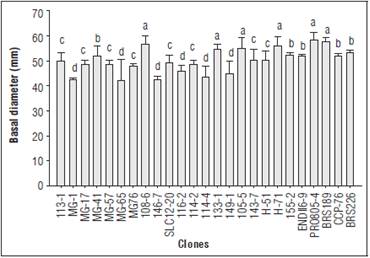
Figure 4 Basal diameter of peduncles of dwarf cashew clones from Cruz, CE. 2017. Averages followed by the same letter do not differ from each other according to the Scott and Knott test (P≤0.05) (n=3)±standard error. Values between 53.73 and 61.82 g were considered ideal.
Group 1 (PRO805-4, 108-6, H-71, 105-5 and 133-1) had the best BD values, in a range between 54.47 and 58.38 mm, superior to the control. Group 2 (clones BRS226, 155-2 and MG-41 together with CCP 76 (54.10 mm) + ENDII6-9) had BD values between 51.72 and 53.03 mm, lower than group 1 and higher than groups 3 and 4. Group 3 (H-51, 143-7, 113-1, SLC12-20, MG-57, 114-2, MG-17 and MG76) was composed of clones expressing BD values between 47.91 and 50.17 mm, lower than the control and superior to group 4. Group 4 (116-2, BRS 189, 1491, 114-4, MG-1, 146-7 and MG-65) had clones with lower BD values, ranging from 42.21 to 45.90 mm.
Studying physical characteristics of different cashew clones, Gomes et al. (2006) found the highest values for clones CCP 76, BRS 189, Embrapa 50 and Embrapa 51, 58.1; 57.6; 54.7 and 54.7 mm, respectively. Values higher than those found in this study.
Abreu (2007), studying the quality and total antioxidant activity of peduncles of commercial clones of dwarf cashews, obtained a general average of 57.68 mm, whose variation was from 50.63 to 61.97 mm. Therefore, the values were higher than those found in this study. On the other hand, Lopes et al. (2011) found even higher values for CCP 76, 65.87 mm.
For the variable apical diameter (AD), a variation of 30.97 to 49.46 mm was found, with an amplitude of 18.49 mm and an overall mean of 41.38 mm (Fig. 5). The clones (BRS189, H-71, 155-2, 114-2, PRO805-4, 105-5, 133-1, BRS226, ENDII6-9, + clone 143-7 and SLC12-20) presented the highest AD values, between 42.15 and 49.46, standing out from group 2 (Tab. 1).
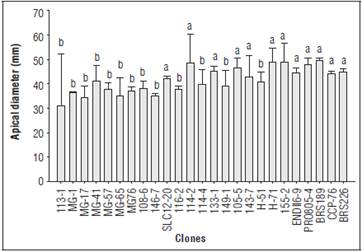
Figure 5 Apical diameter of peduncles of dwarf cashew clones from Cruz, CE. 2017. Averages followed by the same letter do not differ from each other according to the Scott and Knott test (P≤0.05) (n=3)±standard error. Values between 40.81 and 50.27 mm are considered ideal.
Group 2 (MG-41, H-51, 114-4, 149-1, 108-6, MG-57, 116-2, MG76, MG-1, 146-7, MG-65, MG-17 and 113 -1) presented AD values between 30.97 mm and 40.99 mm, which presented lower values than group 1.
Working with CCP clone 76, Pereira et al. (2005), in the Northern Region of Minas Gerais, obtained an AD value higher than 44.40 mm. In the present study, the AD obtained for the same clone was 43.93 mm. It was observed that, for the commercial stage, there was an average variation of 33.99 to 48.87 mm (Lopes et al., 2011), lower than the variation found in this study. When analyzing the peduncle length, a variation of 45.54 to 76.11 mm (Fig. 6) was observed, with an amplitude of 30.57 mm and an overall mean of 62.37 mm.
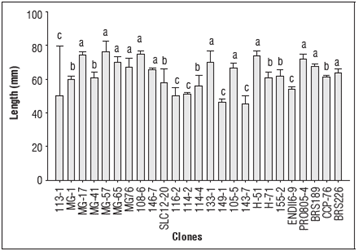
Figure 6 Length of peduncles of dwarf cashew clones from Cruz, CE. 2017. Averages followed by the same letter do not differ from each other according to the Scott and Knott test (P≤0.05) (n=3)±standard error. Values between 67.24 and 76.44 mm are considered ideal.
Group 1 was composed of clones (MG57, 108-6, MG-17, H-51, PRO805-4, 133-1, MG-65, BRS189, MG76, 105-5 and 146-7) and presented the highest medium lengths, with values varying from 63.96 to 76.11 mm, standing out from the other clones, including the CCP 76 control. Group 2 (155-2 + the CCP-76 control (61.56) next to clones H-71, MG-41, MG-1, SLC12-20 and 114-4) showed values ranging from 55.97 to 61.99 mm, inferior to group 1. Group 3 (ENDII6-9, 114-2, 113-1, 116-2, 149-1 and 143-7) presented averages ranging from 45.54 to 54.19 mm, less than the CCP 76 control.
In a study carried out by Lopes et al. (2011) on the physical attributes of peduncles of four different clones at different stages of maturation, it was generally observed that there was an increase in length during development for all clones. The mature CCP 76 had the highest mean, with 67.24 mm, which was higher than the length found for this same clone in the present study (61.56 mm).
As for firmness of the peduncles of the different clones of dwarf cashew, there was a variation of 4.57 to 10.67 N, with an amplitude of 6.1 N and a general average of 7.22 N (Fig. 7). Group 1 (114-2, 114-4, MG-1, MG-17, 143-7, MG-65, 149-1, SLC12-20 and MG-41) was composed of clones that achieved the best firmness averages, with values between 7.97 and 10.67 N, superior to the other groups and presenting greater resistance to mechanical damage. Group 2 (MG76, 105-5, BRS189, 155-2, 108-6, 146-7, MG-57, PRO805-4 H-516ENDII6-9) obtained firmness values ranging from 6.23 to 7.26 N, higher than the control. Group 3 (116-2, BRS226, 133-1, 113-1, H-71 near the control (CCP-76)) showed the lowest firmness values, varying between 4.57 and 6.03 N.
Pereira et al. (2005) found, for clone CCP 76, a firmness value in the central part of the peduncle of 16.95 N, which, according to Almeida et al. (2011), was higher than any other study carried out with this clone in the commercial maturity stage. On the other hand, Lopes et al. (2011), studying the physical characterization of peduncles of dwarf cashew clones in different stages of maturation, observed a value of 7.78 N for CCP 76 in stage 7, superior to the one found in this study for the same clone.
Moura et al. (2001) assessed the physical characteristics of cashew peduncles for natural commercialization, which presented a value of 5.83 N for CCP76, superior to that found in the present study (4.57). Thus, studies have reported that peduncles with a greater firmness value have a longer post-harvest life, which was also sought in this study since it is one of the main objectives of researchers in this line of research.
CONCLUSIONS
For the variables total mass, peduncle mass, basal diameter and length, the best evaluated clone was 108-6 because it presented the highest average; however, when analyzing the nut mass and firmness, it was observed that they were better represented by clone 114-2. Clone 116-2 stood out for apical diameter. Overall, all clones showed good characteristics; however, clone 108-6 was better when evaluating total mass, peduncle mass, basal diameter and length, which stood out from the control (CCP 76).
In general, all clones presented good characteristics; however, clone 108-6 is preferred by most consumers since it has red staining, as does the control (CCP 76). Therefore, all clones presented desirable characteristics for natural consumption and/or processing.













